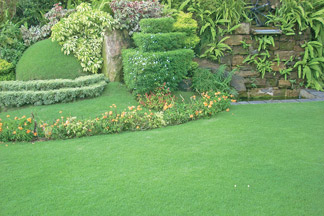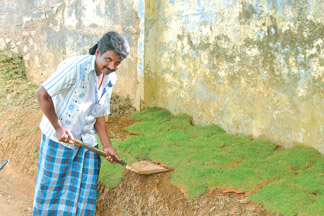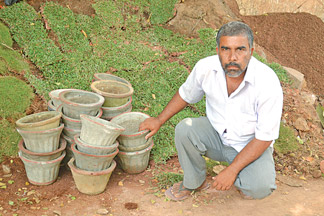|
Turf sod sellers in a rewarding livelihood:
A green, green grass for home
By Ananda KANNANGARA
|

A landscaped garden
|
Owning a beautifully landscaped garden would be anybody's dream. In
laying out the lawn, do you know the amount of effort that goes into
preparing it?
People in urban areas, such as in Colombo would have seen vendors
engaged in selling turf sods (Tanakola Pidali). Bauddhaloka Mawatha in
Colombo (Bullers Road) is a famous location for selling turf sods.
Hundreds of people living in Colombo and suburban areas visit
Bauddhaloka Mawatha to buy turf sods to plant in their gardens.
If anybody has seen how people are engaged in the turf sod cutting
job at places such as Avissawella and Pelmadulla in the Sabaragamuwa
Province or at Padukka, Hanwella and Waga, he would definitely say that
it was not only a hard-earned job, but also a risky job.
The Sunday Observer last week visited a number of villages at Padukka,
Hanwella, Avissawella, and Ratnapura area to meet people whose
livelihood is the sod cutting job. Not only elderly people, but also
children are engaged in the job. Some have been engaged in traditional
turf cutting for the past forty years.
The grass is grown in deep slopes. People cut the turf sods in a
systematic way and carry them on shoulders to the main road after
passing a distant of nearly two kilometres.
A prominent worker who has been engaged in the turf cutting job,
54-year-old, P.L. Gunapala of Kuruwita, Ratnapura said he took over the
business after his father's demise in 1970.
He said his grandfather started the turf cutting job in the 1920s and
his father took over the business thereafter.
"My income is about Rs. 1,500 a day and I sell the stuff to buyers
coming from Colombo", he said.
 |
| Soil mixed
with fertiliser |

Cutting turf sods |

Displaying a sod |

Selling turf sod |
The turf sod cutting business has been the livelihood of over 20
families in the Kudagama in Avissawella.
The business was carried out profitably at Kudagama even during the
colonial era when British rulers were in the country.
The book titled 'The Art of Landscaping', says that a British
Governor, John Moore had visited a village in Pelmadulla, Ratnapura
during the early part of 1930s in search of gem mines. During his short
stay in the village he spotted a rare variety of beautiful green grass
which he had first seen in the lawn of the Buckingham Palace.
He himself cut two sods and replanted them at his official residence
in Cinnamon Gardens, Colombo 7. At that moment the garden was full of
cinnamon trees and no grass were seen. The green grass which he brought
from Pelmadulla was grown in the lawn.
This rare variety which is very expensive even today is called as
'Australian grass'.
The cost of a sod of this Australian turf in the today's market is
between Rs. 80 to Rs. 100.
A resident of Bauddhaloka Mawatha, Borella and a long-standing
businessman whose livelihood is selling turf sods Abubaker Rasuldeen
said, in addition to Australian grass which is the most expensive in the
today's market, a square feet of other varieties such as Malaysian grass
which is rated next is sold at Rs. 70, a square feet of Burmuda grass,
Running grass, Blow grass and Undupiyali are sold at Rs. 10 each, while
a square feet of Buffalo grass which is commonly seen everywhere is sold
at Rs. Five each.
A resident of Lellopitiya village in the Sabaragamuwa Province,
63-year-old Nemsiri Karunapala narrated a story of the arrival of
`Australian Grass' to Sri Lanka.
He said a group of Australian citizens had visited Lellopitiya,
Ratnapura to buy gems during 1920s.
They were living in a house at Lellopitiya for several weeks. As the
lawn of their garden was full of weeds they had brought this variety
from their hometown, Sydney. Thereafter people called the variety as
`Australian grass'.
The variety is thin and short. It needs little fertiliser to grow and
also water everyday, but does not grow fast such as other varieties.
Unlike other varieties, the leaves of Australian and the Malaysian
varieties give a fresh look even at dusk. The Australian grass also
needs a cold climate.
Our visit to Meepe, Padukka was unforgettable. About fifteen families
in the village are engaged in the sod cutting job. We visited a lonely
three-acre land to watch the art of cutting grass sods. A group of six
men and a child were engaged in the business at that time. They were
under the impression that we were sent by the Environmental Ministry to
check whether they were destroying the environment by cutting sods of
turf, which made them reluctant to face us.
But fortunately later they came to give details of their industry for
a newspaper article.
According to 47-year old M.L. Suranimala, sod-cutting was the
livelihood of at least fifteen families in the village.
"There are lots of State owned lands in our area. We cut sods of turf
which are on bare lands and on mountain slopes", he said.
He said buyers from Colombo and suburban towns visit their village
two days a week to purchase the turf sods.
We have also grown Australian grass in several lands owned by
individuals and we have to keep a close tab on this variety until they
grow up.
A businessman, Dayasiri Peris of Moratuwa said he has been involved
in the industry for the past twenty years and gets a monthly income of
Rs. 80,000.
He said he visits sod cutting places at Hanwella and Avissawella
twice a week and brings a lorry load of turf sod.
"I have a business place in a by-road at Bauddhaloka Mawatha, Borella
and in addition I provide turf sods to hotels in Colombo and also to
bungalows. I also take orders to lay turf sods in home gardens,"he said.
He said unlike earlier, there is no improvement in our business due
to the arrival of synthetic grass to the country.
He lamented over the laying of imported synthetic grass in some
bungalows in Colombo and also in some playgrounds.
He therefore appealed to Government authorities to refrain from
importing synthetic grass to the country as it will badly affect the
economy as well as the environment.
A long-standing turf sod seller, Sirisena Amarapala said, earlier
about 25 families in Colombo did the turf sod selling business along the
Bauddhaloka Mawatha, oppopsite the D.S. Senanayaka Vidyalaya, but due to
objections from the Colombo MMC and the Police all of them had to leave
their traditional business premises.
He said due to this, only about five families are engaged in the
business along Ashroff Mawatha and unlike earlier, their business has
gone down. He appealed to the authorities to allow them to start their
turf sod selling business along the Bauddhaloka Mawatha once again, as
it was one business that will never pollute the environment. |

